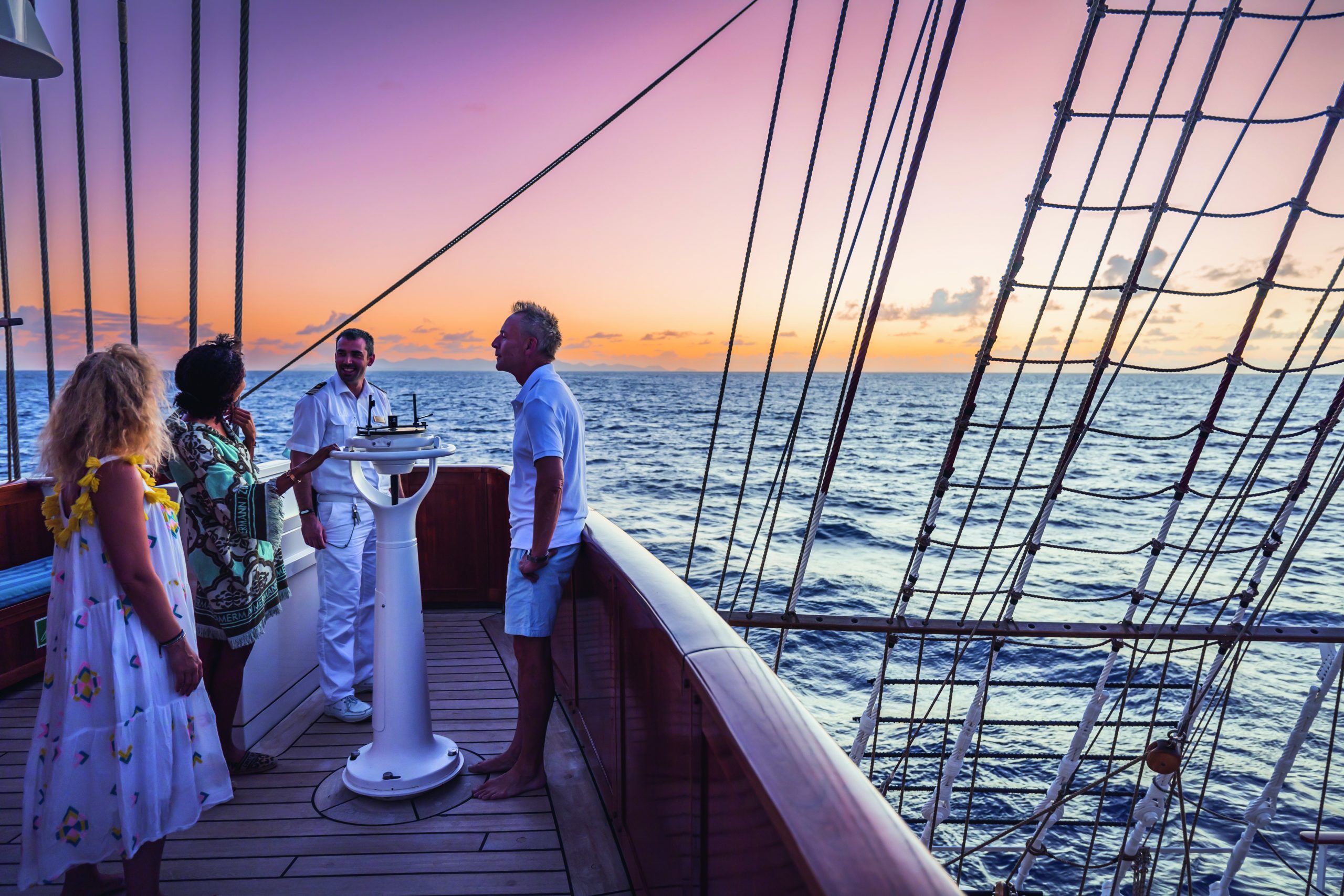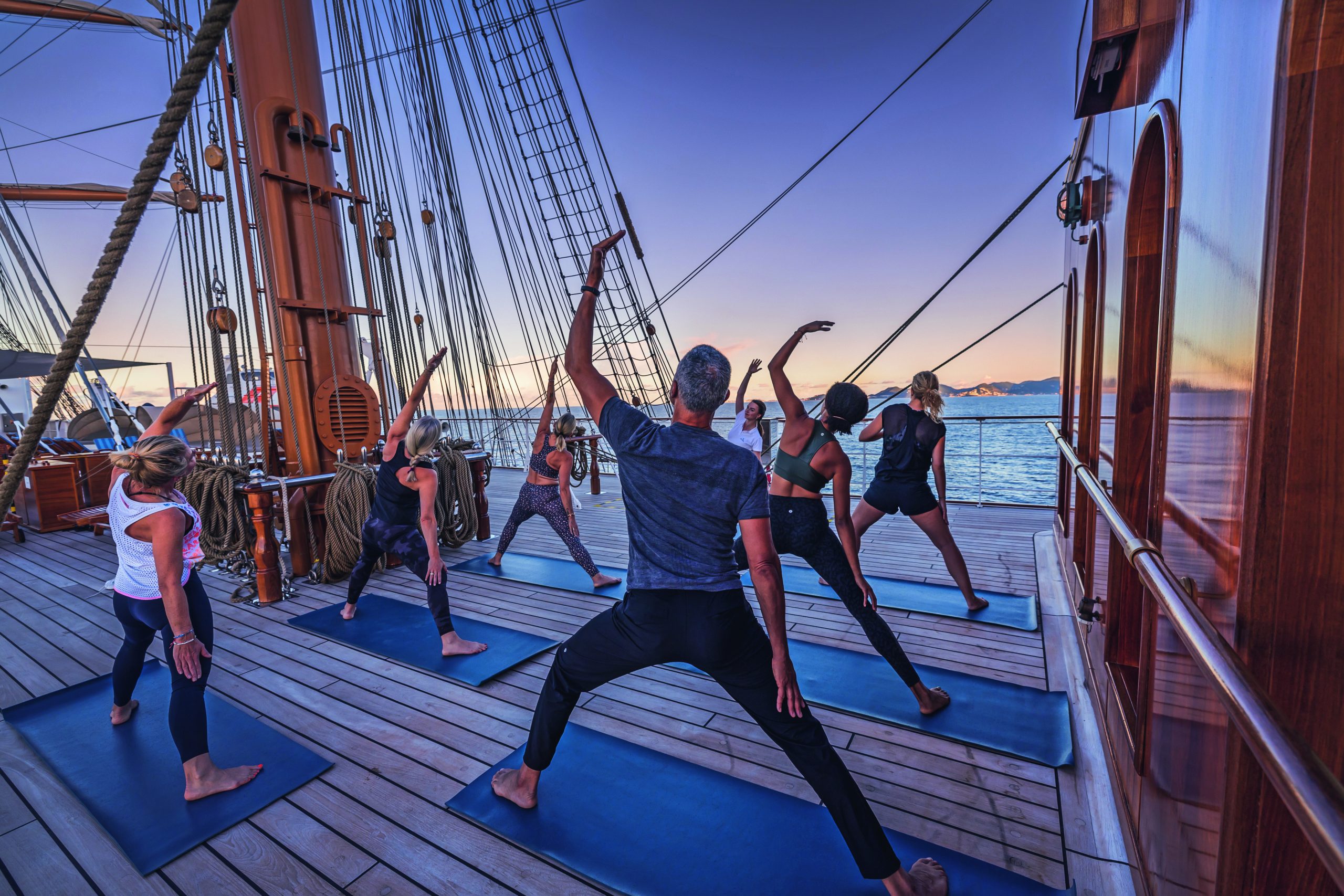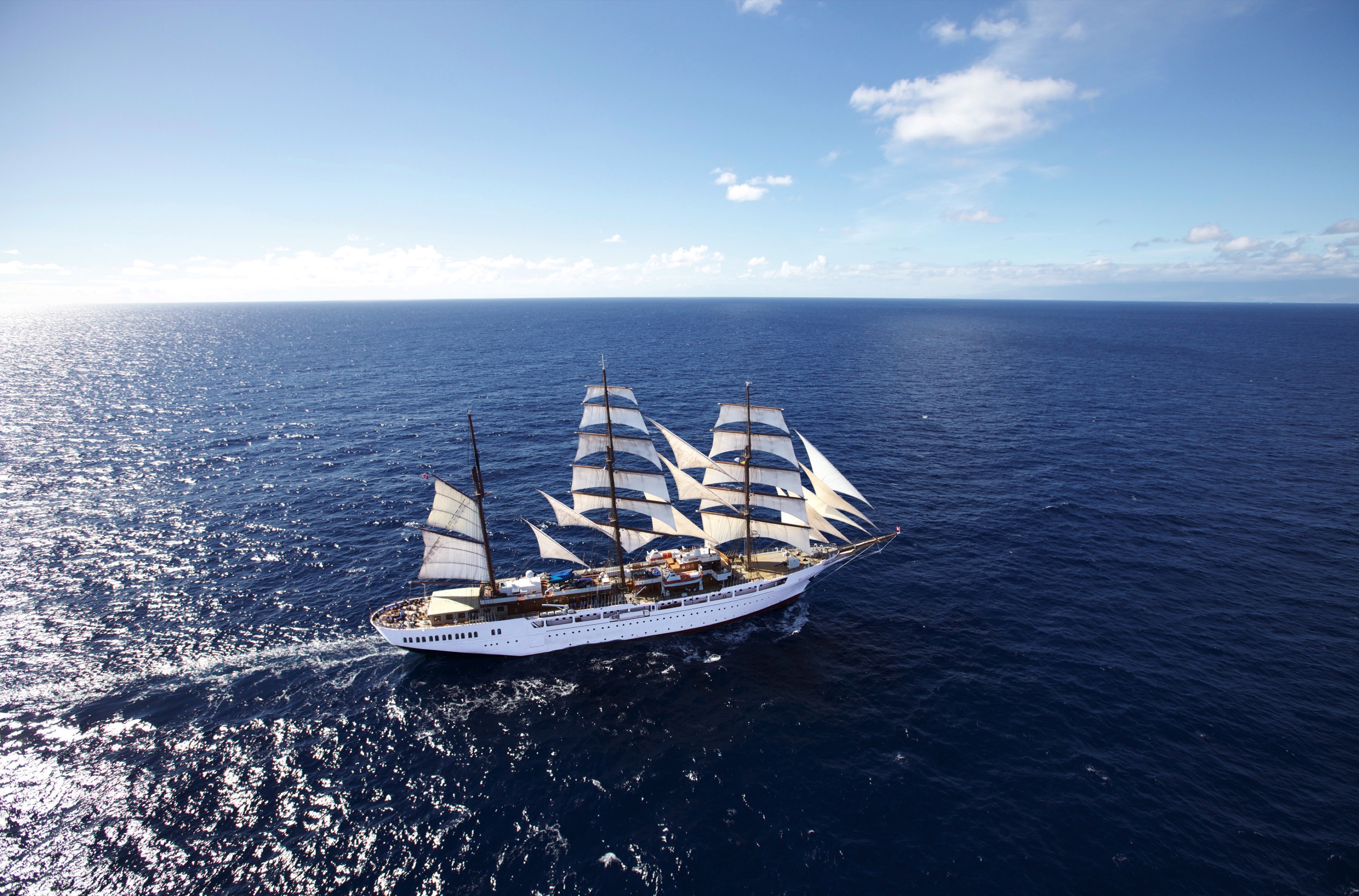Itinerary
Catania is an ancient port city on Sicily’s east coast. It sits at the foot of Mt. Etna, an active volcano with trails leading up to the summit. The city’s wide central square, Piazza del Duomo, features the whimsical Fontana dell’Elefante statue and richly decorated Catania Cathedral. In the southwest corner of the square, La Pescheria weekday fish market is a rowdy spectacle surrounded by seafood restaurants.
The medieval cliff-hanging town of Taormina is overrun with tourists, yet its natural beauty is still hard to dispute. The view of the sea and Mt. Etna from its jagged cactus-covered cliffs is as close to perfection as a panorama can get—especially on clear days, when the snowcapped volcano’s white puffs of smoke rise against the blue sky. Writers have extolled Taormina’s beauty almost since it was founded in the 6th century BC by Greeks from nearby Naxos; Goethe and D. H. Lawrence were among its well-known enthusiasts. The town’s boutique-lined main streets get old pretty quickly, but the many hiking paths that wind through the beautiful hills surrounding Taormina promise a timeless alternative. A trip up to stunning Castelmola (whether on foot or by car) should also be on your itinerary.
Located right in the heel of the Italian boot, Otranto’s scenic landscape often plays the protagonist in displaying the beauty of Puglia, Italy’s easternmost region. Facing the Adriatic sea, the seducing weather and pristine waters have made it a popular destination where on a clear day, wanderers can see the coast of Albania. Like much of Italy, the city boasts a rich and mixed history. Once a Greek and Roman port, it was later occupied by the Byzantines, the Normans and the Spanish before the Ottoman invaded in during their Jihad to conquer Europe. Remains of forts are still visible and are a living testimonial of the town’s rich history along with Otranto’s cathedral, which still encloses today the relics of martyrs who refused to convert to Islam.
Bari, capital of the province of Apulia, lies on southern Italy’s Adriatic coast. Its busy port is a leading commercial and industrial centre as well as a transit point for travellers catching ferries across the Adriatic to Greece. Bari comprises a new and an old town. To the north, on a promontory between the old and new harbours, lies the picturesque old town, or Citta Vecchia, with a maze of narrow, crooked streets. To the south is the spacious and regularly planned new town, which has developed considerably since 1930, when the Levant Fair was first held here. The heart of the modern town is Piazza della Liberta. The busy thoroughfare, Corso Vittorio Emanuele II, separates the new town from the old. At the eastern end of the Corso begins the Lungomare Nazario Sauro, a magnificent seafront promenade that runs along the old harbour. Bari and the Apulian region were long recognized for their strategic location, attracting a succession of colonizers such as the Normans, Moors and Spaniards, each leaving their mark.
One of the true jewels of the Mediterranean, Rovinj is a jaw-droppingly beautiful town, which juts out into sparkling Mediterranean. Dominated by the pencil-like bell tower of the Venetian Saint Euphemia Cathedral, pine tree forests flow to the borders of the quaint Old Town – which evokes the romantic, tangled backstreets of the Venice. Rovinj – or Rovino in Italian – is a city of split personalities, with two official languages – having been owned by the Kingdom of Italy between 1919 and 1947.
Šibenik’s main monument, its Gothic-Renaissance cathedral, built of pale-gray Dalmatian stone and designated a UNESCO World Heritage Site, stands on a raised piazza close to the seafront promenade. From here a network of narrow, cobbled streets leads through the medieval quarter of tightly packed, terra-cotta–roof houses, and up to the ruins of a 16th-century hilltop fortress. The city has never been a real tourist destination. Before the Croatian war for independence, it was a relatively prosperous industrial center, but when the factories closed, Šibenik sank into an economic depression. However, the cathedral more than warrants a look, and it makes a decent base for visiting the waterfalls of Krka National Park.
Nothing can prepare you for your first sight of Dubrovnik. Lying 216 km (135 miles) southeast of Split and commanding a jaw-dropping coastal location, it is one of the world’s most beautiful fortified cities. Its massive stone ramparts and fortress towers curve around a tiny harbor, enclosing graduated ridges of sun-bleached orange-tiled roofs, copper domes, and elegant bell towers. Your imagination will run wild picturing what it looked like seven centuries ago when the walls were built, without any suburbs or highways around it, just this magnificent stone city rising out of the sea.In the 7th century AD, residents of the Roman city Epidaurum (now Cavtat) fled the Avars and Slavs of the north and founded a new settlement on a small rocky island, which they named Laus, and later Ragusa. On the mainland hillside opposite the island, the Slav settlement called Dubrovnik grew up. In the 12th century the narrow channel separating the two settlements was filled in (now the main street through the Old Town, called Stradun), and Ragusa and Dubrovnik became one. The city was surrounded by defensive walls during the 13th century, and these were reinforced with towers and bastions in the late 15th century.From 1358 to 1808 the city thrived as a powerful and remarkably sophisticated independent republic, reaching its golden age during the 16th century. In 1667 many of its splendid Gothic and Renaissance buildings were destroyed by an earthquake. The defensive walls survived the disaster, and the city was rebuilt in baroque style.Dubrovnik lost its independence to Napoléon in 1808, and in 1815 passed to Austria-Hungary. During the 20th century, as part of Yugoslavia, the city became a popular tourist destination, and in 1979 it was listed as a UNESCO World Heritage Site. During the war for independence, it came under heavy siege. Thanks to careful restoration, few traces of damage remain; however, there are maps inside the Pile and Ploče Gates illustrating the points around the city where damage was done. It’s only when you experience Dubrovnik yourself that you can understand what a treasure the world nearly lost
Nothing can prepare you for your first sight of Dubrovnik. Lying 216 km (135 miles) southeast of Split and commanding a jaw-dropping coastal location, it is one of the world’s most beautiful fortified cities. Its massive stone ramparts and fortress towers curve around a tiny harbor, enclosing graduated ridges of sun-bleached orange-tiled roofs, copper domes, and elegant bell towers. Your imagination will run wild picturing what it looked like seven centuries ago when the walls were built, without any suburbs or highways around it, just this magnificent stone city rising out of the sea.In the 7th century AD, residents of the Roman city Epidaurum (now Cavtat) fled the Avars and Slavs of the north and founded a new settlement on a small rocky island, which they named Laus, and later Ragusa. On the mainland hillside opposite the island, the Slav settlement called Dubrovnik grew up. In the 12th century the narrow channel separating the two settlements was filled in (now the main street through the Old Town, called Stradun), and Ragusa and Dubrovnik became one. The city was surrounded by defensive walls during the 13th century, and these were reinforced with towers and bastions in the late 15th century.From 1358 to 1808 the city thrived as a powerful and remarkably sophisticated independent republic, reaching its golden age during the 16th century. In 1667 many of its splendid Gothic and Renaissance buildings were destroyed by an earthquake. The defensive walls survived the disaster, and the city was rebuilt in baroque style.Dubrovnik lost its independence to Napoléon in 1808, and in 1815 passed to Austria-Hungary. During the 20th century, as part of Yugoslavia, the city became a popular tourist destination, and in 1979 it was listed as a UNESCO World Heritage Site. During the war for independence, it came under heavy siege. Thanks to careful restoration, few traces of damage remain; however, there are maps inside the Pile and Ploče Gates illustrating the points around the city where damage was done. It’s only when you experience Dubrovnik yourself that you can understand what a treasure the world nearly lost
Ship features

Luxury Owner Suites (Cat. A)
Our two owner suites follow the tradition in the maritime world of always having their own cabins ready for the ship owners. We have reserved these living areas for those of our guests who appreciate special comfort and cosiness even on board a tall ship. Both light-flooded suites are located on the lidodeck and with their large panoramic windows offer a unique view of the sea even from a four-poster bed. The spacious ambience includes selected individual pieces of furniture, four large cupboards, the fireplace – and last but not least the large bathroom with bathtub and separate shower, marble washstand including the legendary golden fittings.
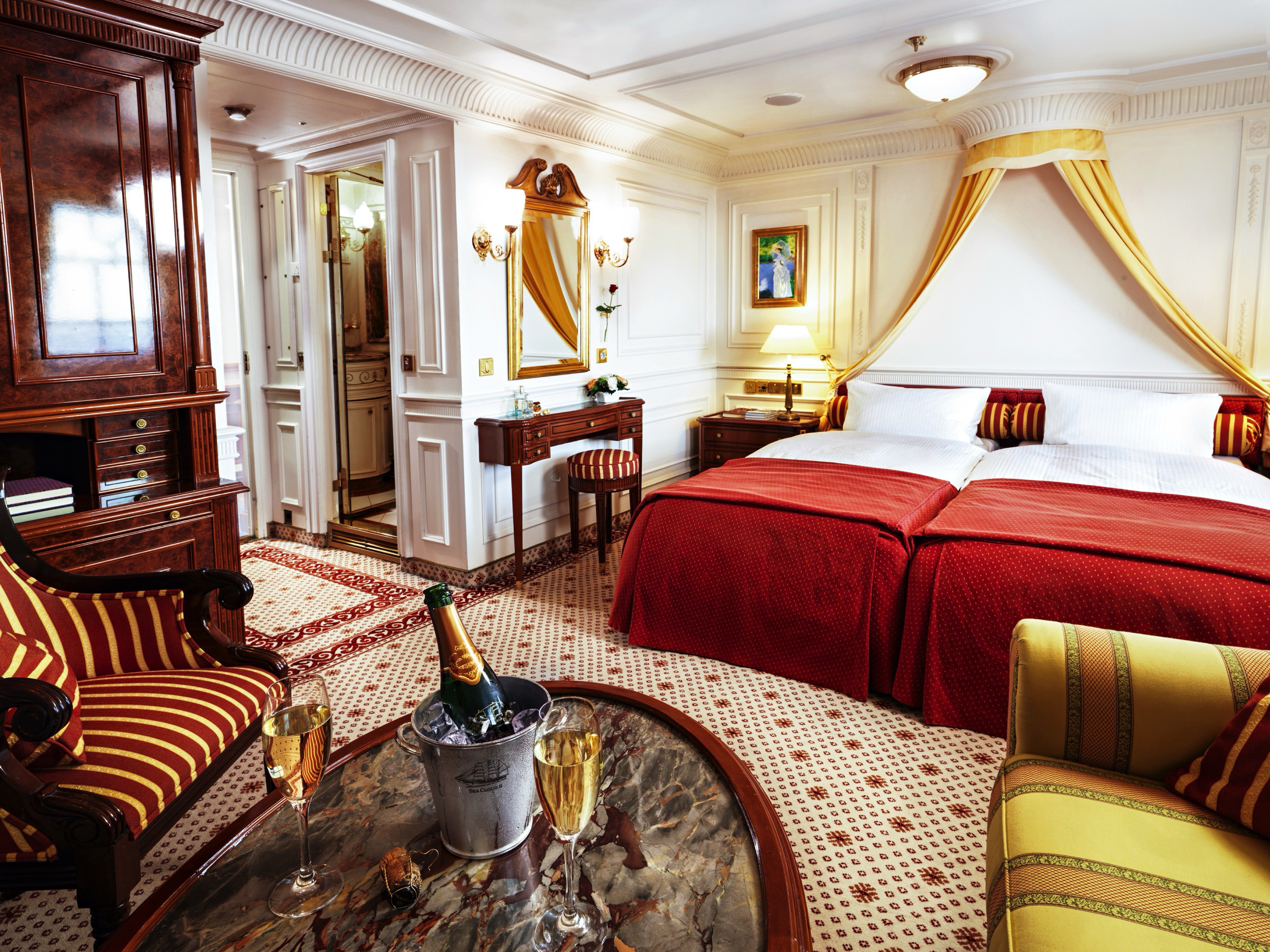
Junior Suites (Cat. B)
With their rosewood furniture, stucco elements on the walls and a decorative marble fireplace, the Junior Suites are the epitome of Hanseatic solidity. The simple elegance corresponds in gentle tension with the maritime atmosphere in front of the panorama windows, which offer a view of the vastness of the sea. A separate sitting area and a walk-in closet round off the comfortable ambience. Bathtub, marble washbasin and golden fittings are of course also standard in this category. The junior suites are located on the promenade deck, so that the restaurant, boutique and reception can easily be reached.
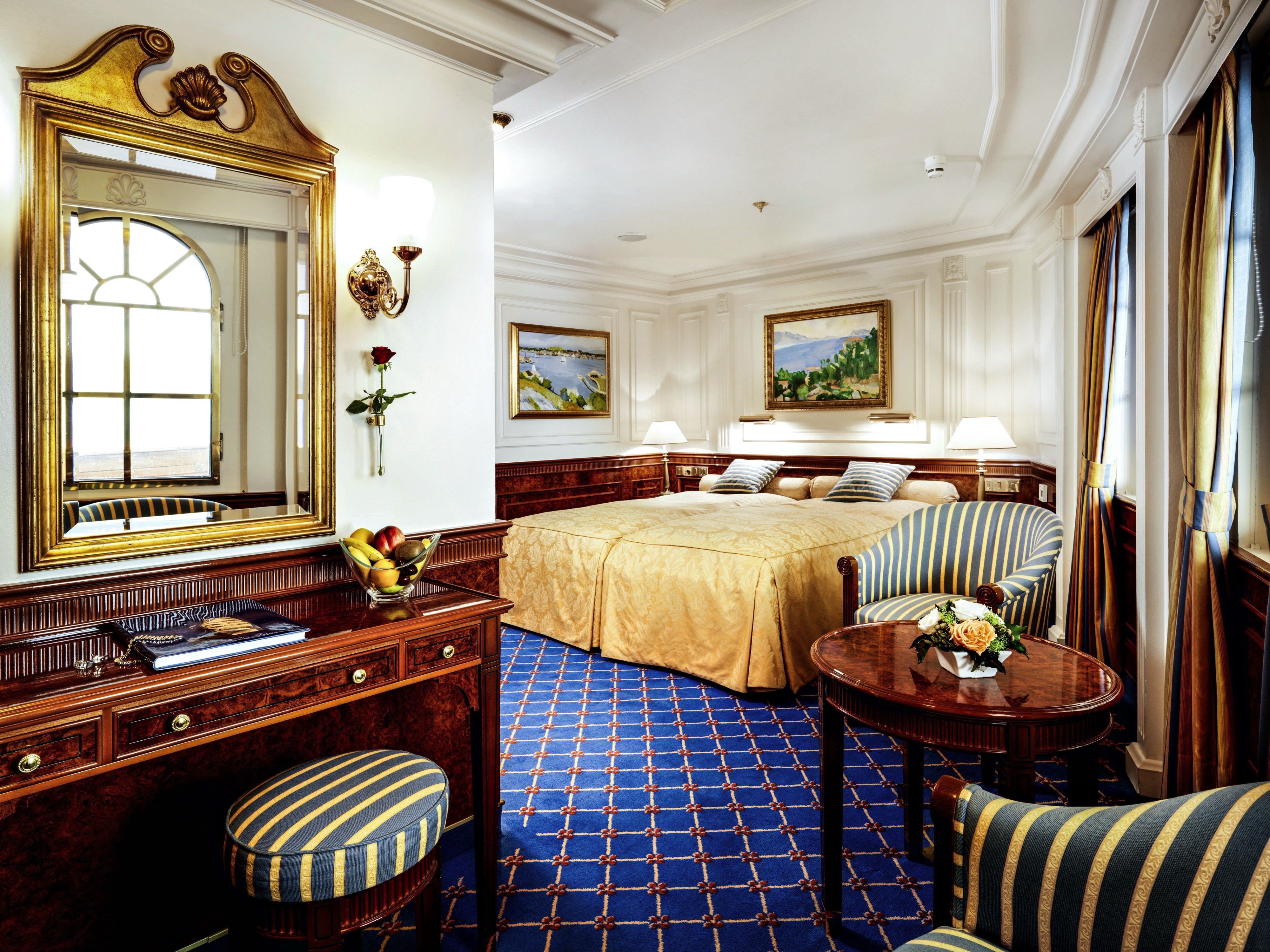
De Luxe Double-Bed Cabins (Cat. C)
This De-Luxe outside cabin combines the comfort and solidity that characterizes the suites with a special maritime cosiness. Thanks to its location in the front area of the promenade deck, the floor plan follows the elegant line of the SEA CLOUD II and thus additionally conveys the feeling of security on a luxury private yacht. The panorama windows offer a wonderful view of the sea.
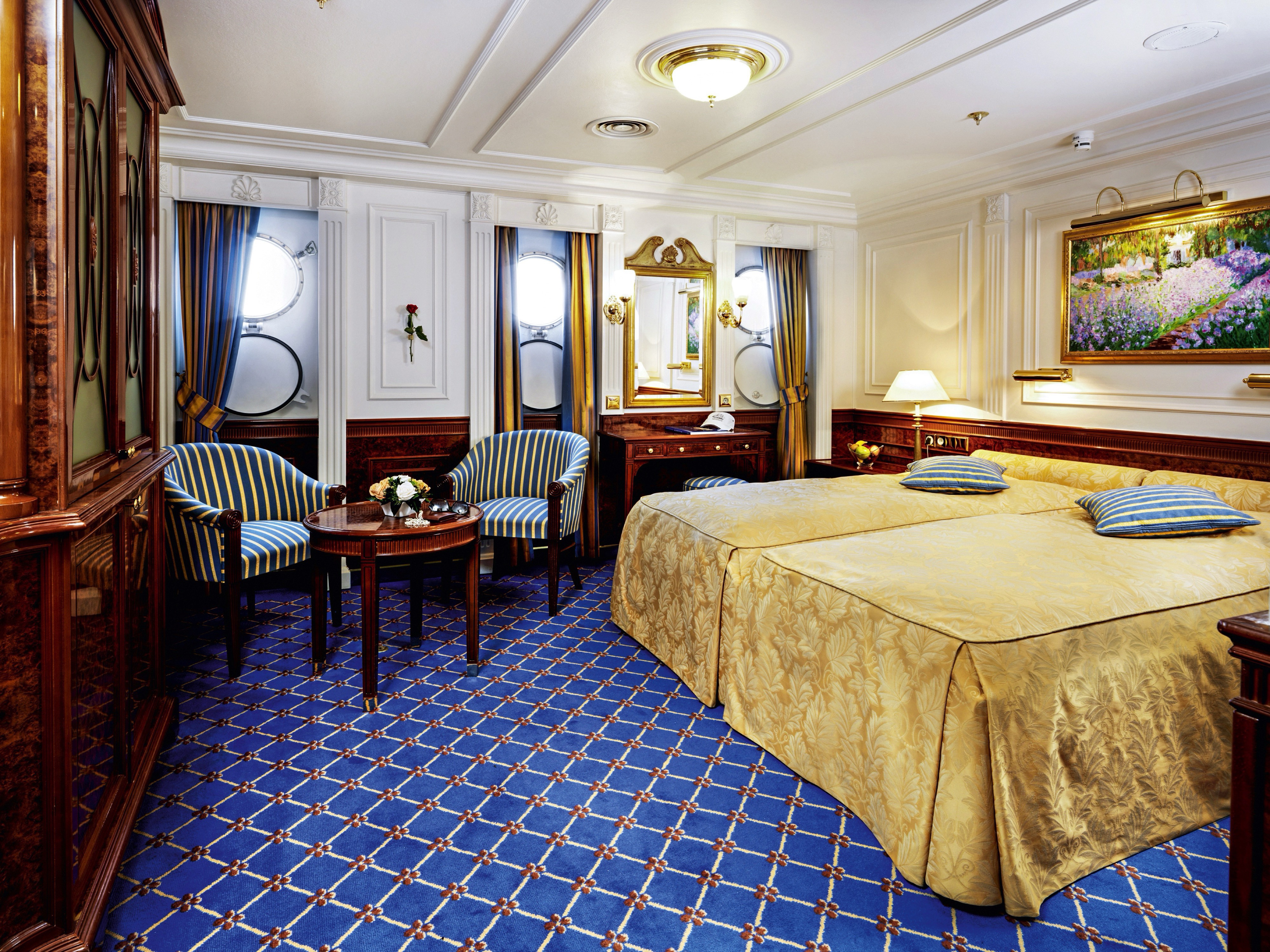
De Luxe Double-Bed Cabins (Cat. D)
The three large porthole windows give our De-Luxe Category D outside cabins a special maritime flair. Together with their luxurious yacht ambience, these cabins underline the feeling of being part of an extraordinary journey on an extraordinary ship. Stylish individual pieces of furniture and a beautiful seating area make the spacious room cosy. The six De-Luxe outside cabins are located amidships on the same deck where the massage and cosmetic treatments, the fitness room, the bathing platform and the hospital are located.

De Luxe Double-Bed Cabins (Cat. E)
These outside cabins on both sides of the cabin deck are the epitome of cosiness on board the SEA CLOUD II. This is where you can retreat, switch off and relax while enjoying the unique luxurious ambience for which our yachts are famous. Like the other cabins, Category E is equipped with TV/DVD, a mini-bar and a safe. An interesting detail: the double bed can be divided into two single beds on request.

Upper-/Lower-Bed Cabins (Cat. F)
This outside cabin on the cabin deck is still modelled on the officers’ cabins as on traditional windjammers and is equipped with an upper and lower berth. Warm woods and a comfortable sitting area radiate a cosy, maritime atmosphere and offer you a cosy retreat. Our recommendation: this cabin is ideal for single travellers.
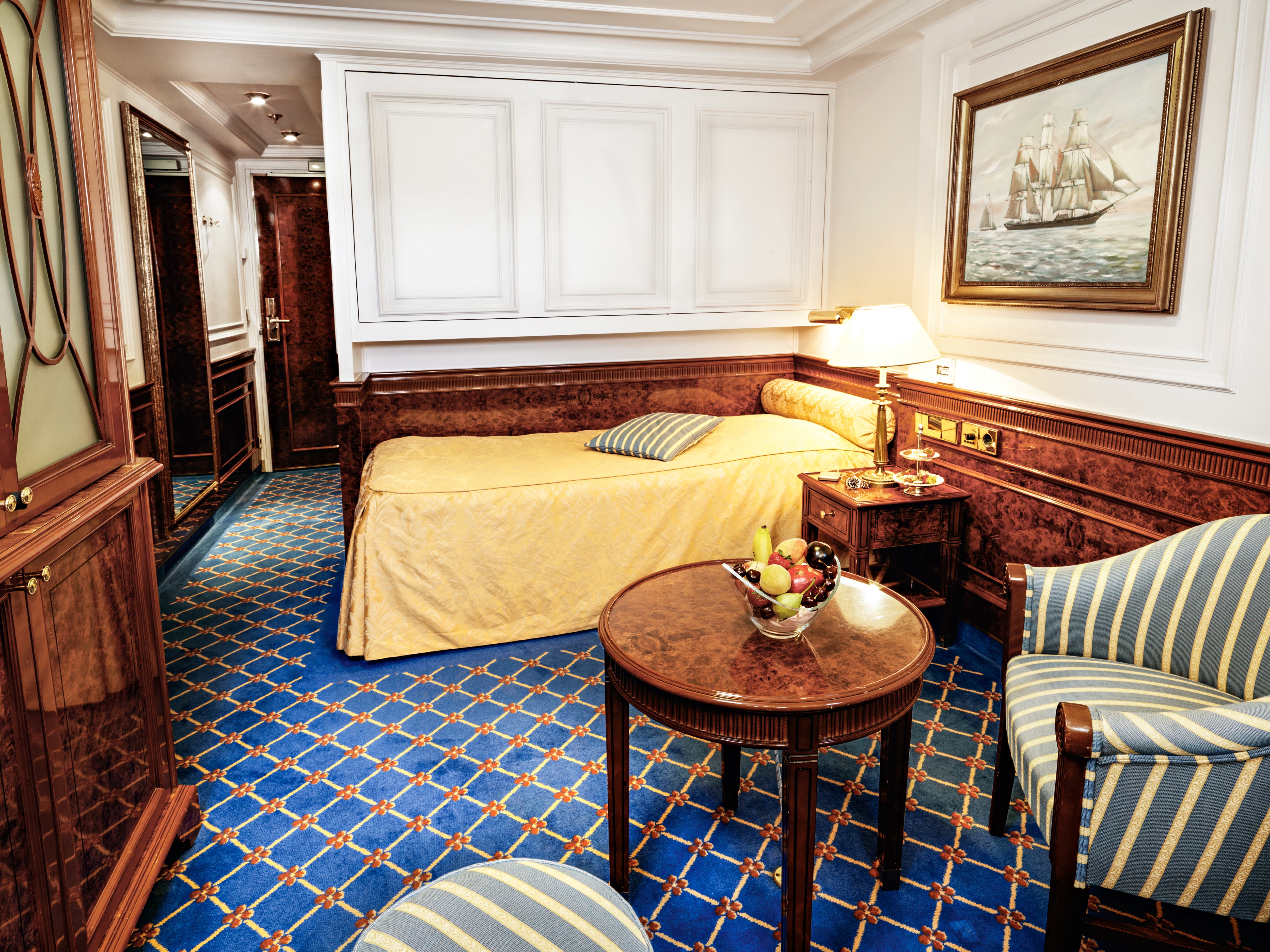
Guarantee Cabins
Guaranteed double cabins: The range of accommodation starts from Cat. F. You will receive your exact cabin number when arriving on board. The allotment for this category is very limited.
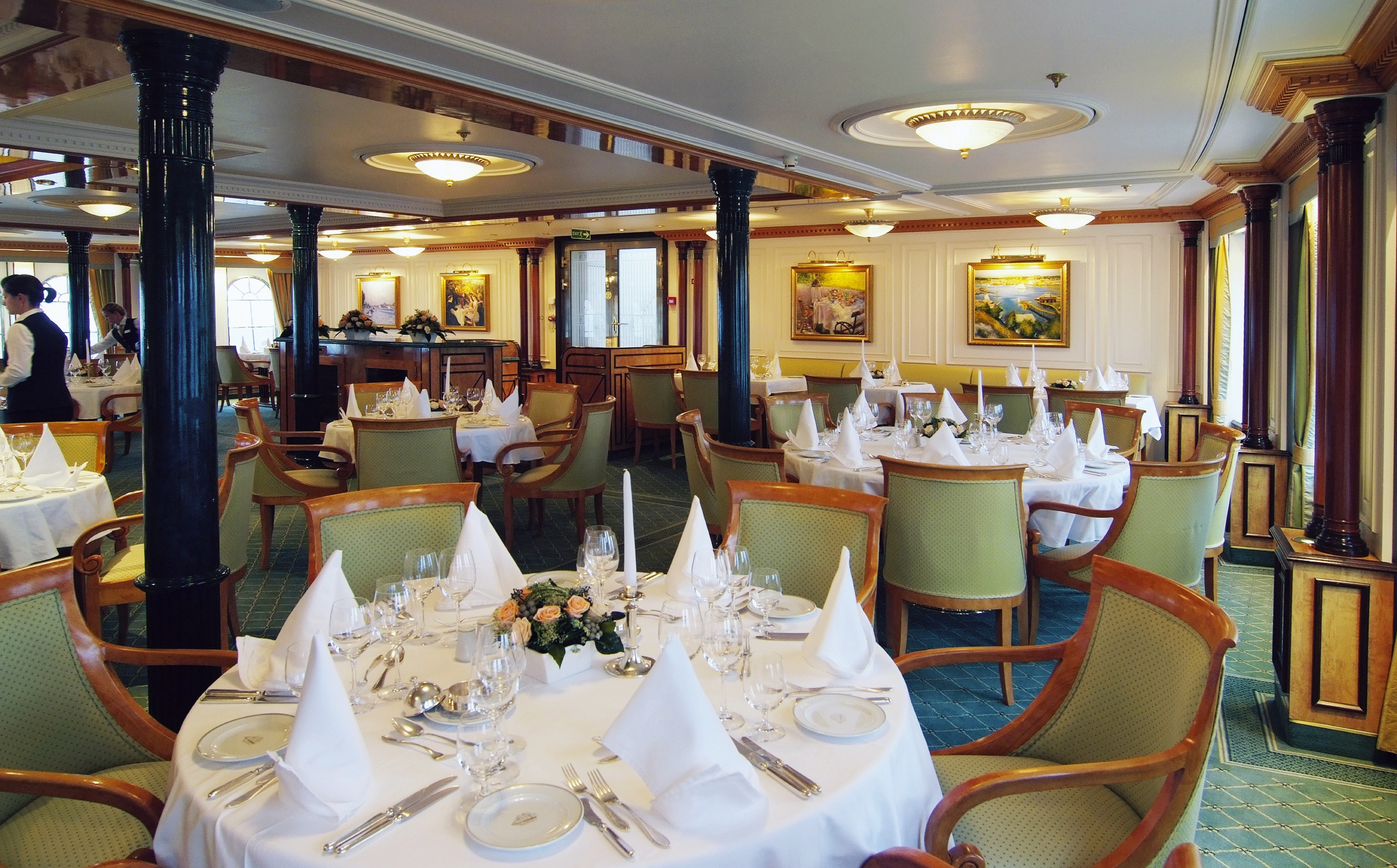
Restaurant
In the restaurant you will find tables for couples and groups of four, six and eight. The lido deck is often an inviting place to have lunch or an evening barbecue out in the open air. No matter whether you are sitting inside or outside, you can all enjoy this feast for the senses together in the same sitting. And since you are dining on a tall ship with the character of a private yacht, you are free to choose your place and company at the table. Our culinary creations are sure to impress even the most discerning of connoisseurs – it is easy to see why the SEA CLOUD II was chosen to join the exclusive Chaîne des Rôtisseurs group.
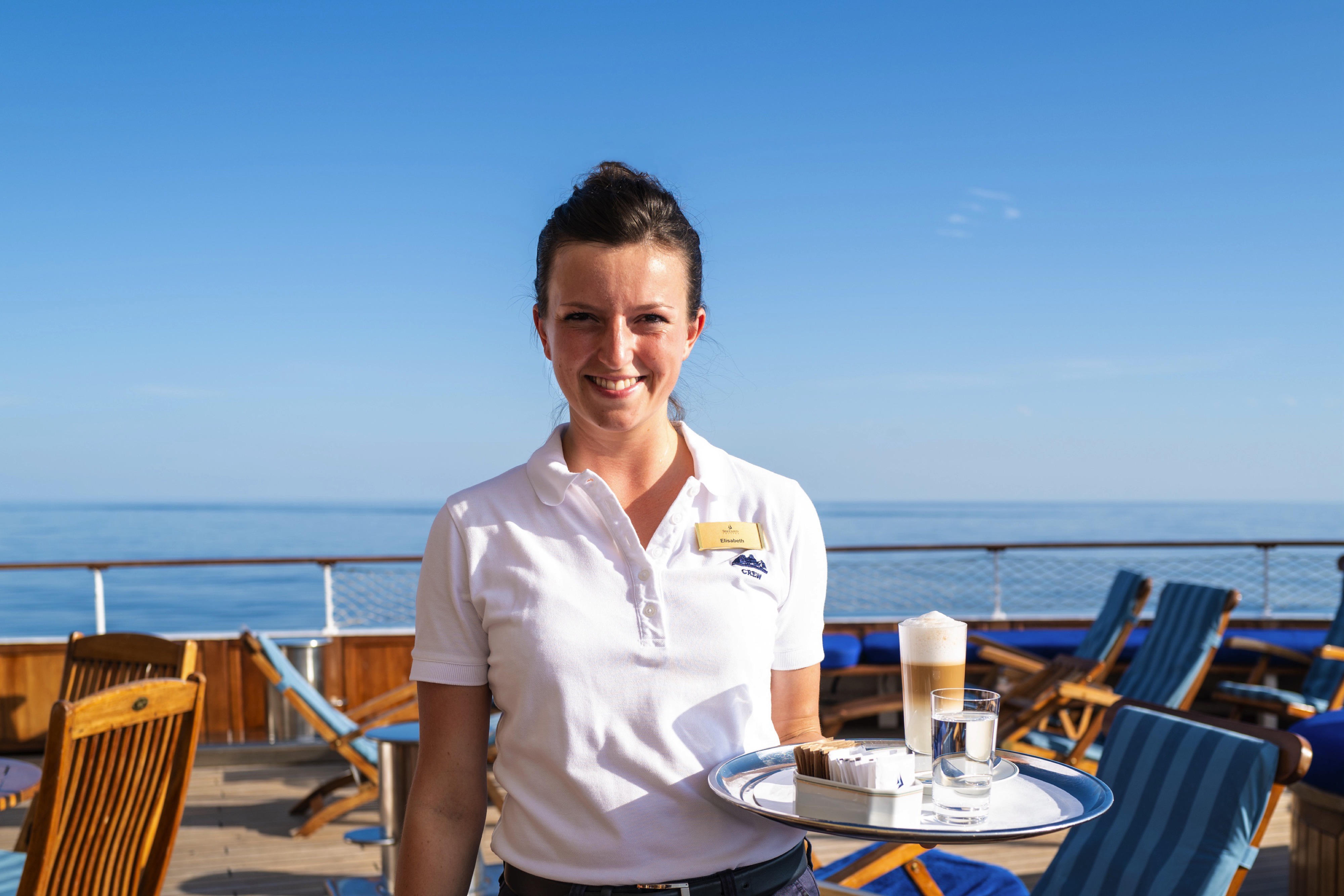
Lido Deck
You will find a dining area and Lido Bar on the Lido Deck.
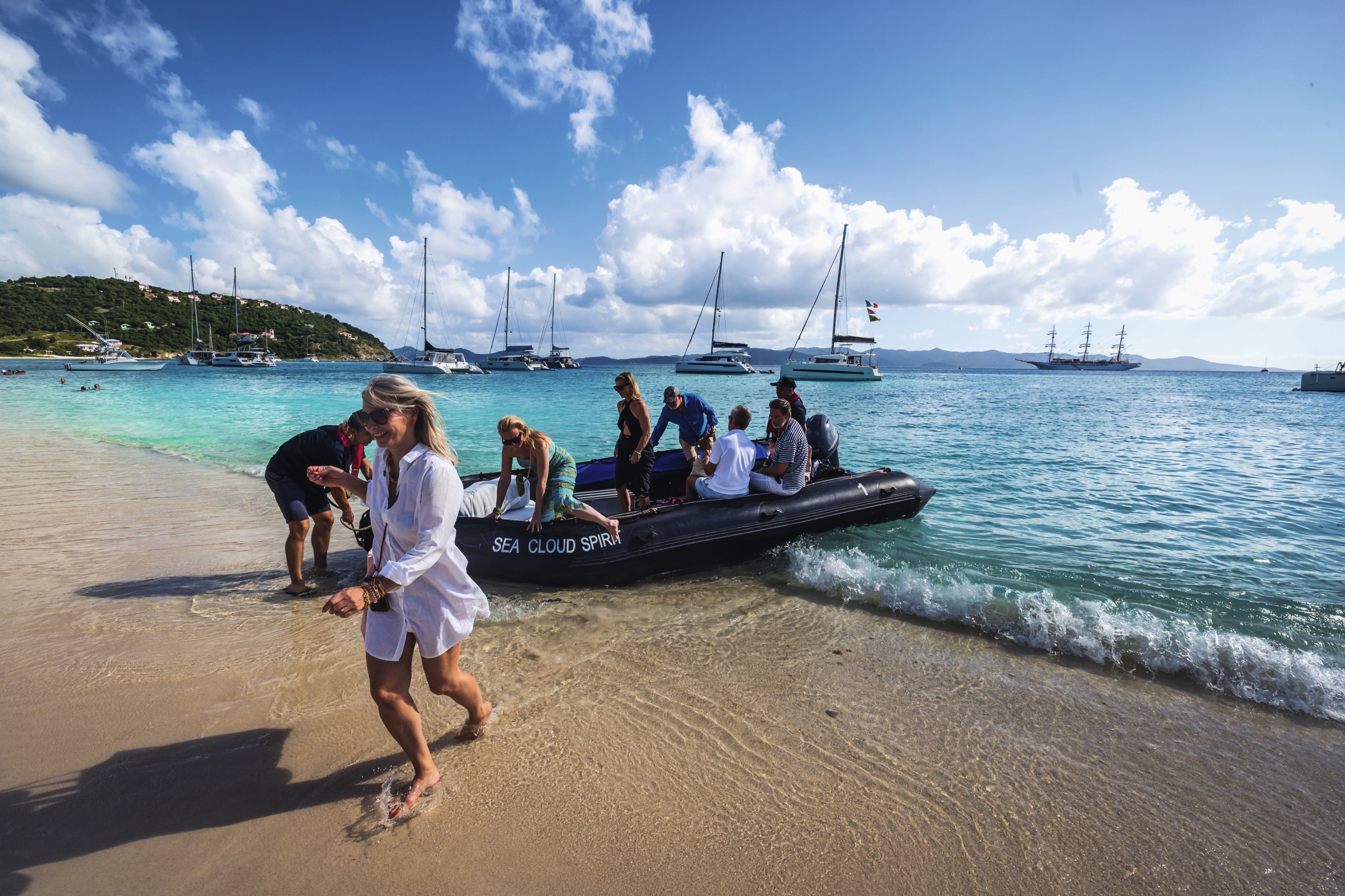
Zodiacs
Smaller ships, greater possibilities
Among the many joys of travelling smaller: a quick spin on a zodiac, enjoying the beach barbeques in secluded bays, photo safaris, pausing for a dip in the azure sea. And on selected tours, some exclusive experiences are included – a private concert, an opera house or a palace tour, a culinary visit to a special vineyard, or a front-row seat at a legendary regatta.
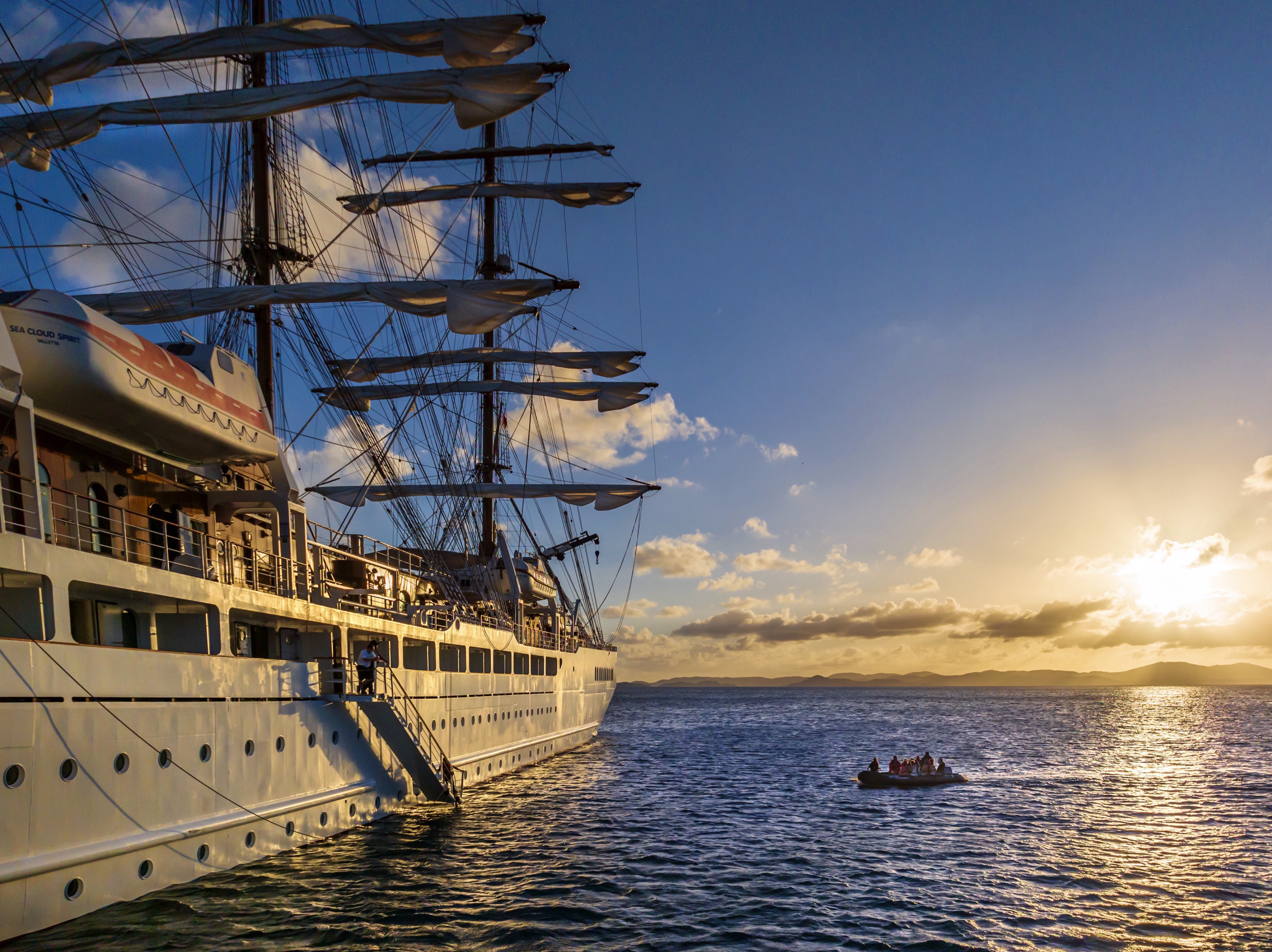
Watersports
Dive in and be active
Whether you want to start your swim directly from the ship or explore the colorful world on the reef – water sports are even more fun under the Caribbean sun. Equipment is available for everyone: Snorkels, fins and stand-up paddles are waiting for you. If you are in the mood for even greater action, let yourself be glided across the crystal clear waters by tubing in the Caribbean.
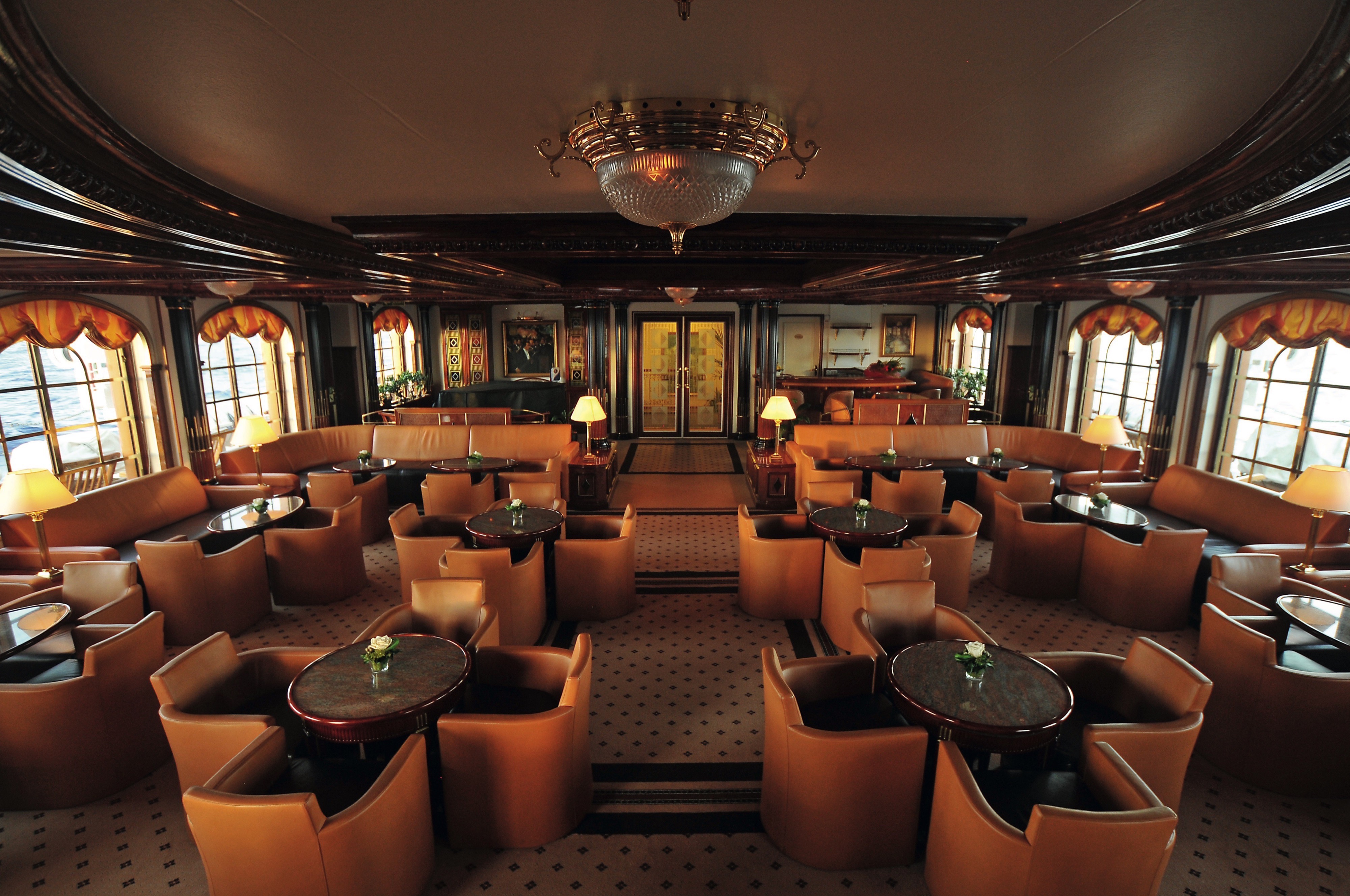
Lounge
In the middle of the lido deck you will find the spacious lounge. At certain times you will hear gentle music from the Steinway piano and, on selected cruises, you can listen to some interesting talks.
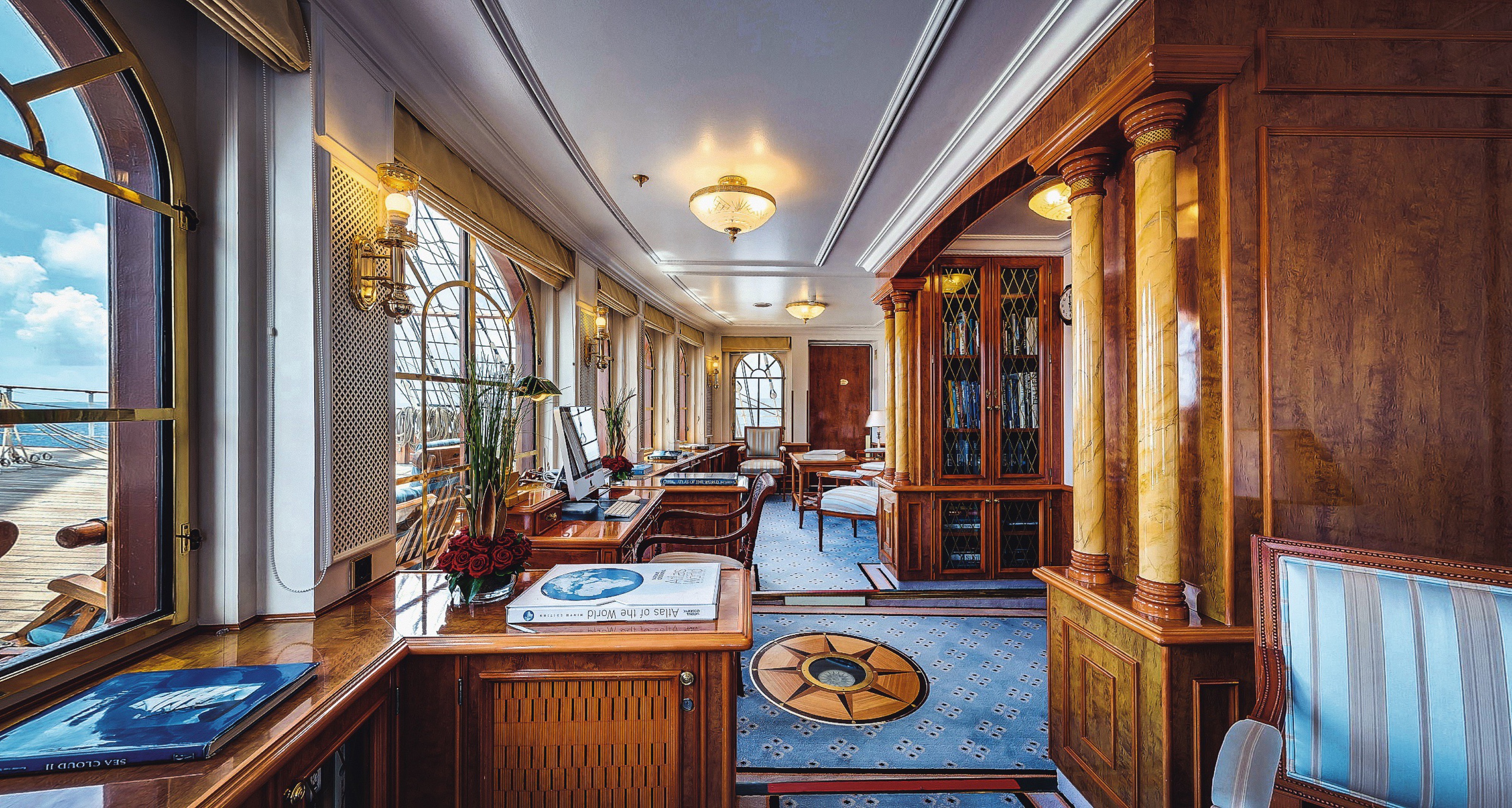
Library
Also on the Lido Deck, you will find the library on the lido deck which contains selected literature, DVDs, popular board games, the SEA CLOUD II’s intriguing guest book and a laptop with internet access. But this is not just a place to get engrossed in reading; you should also enjoy the breathtaking all-round view of the ship’s forecastle – do not forget that you are on board a majestic tall ship!
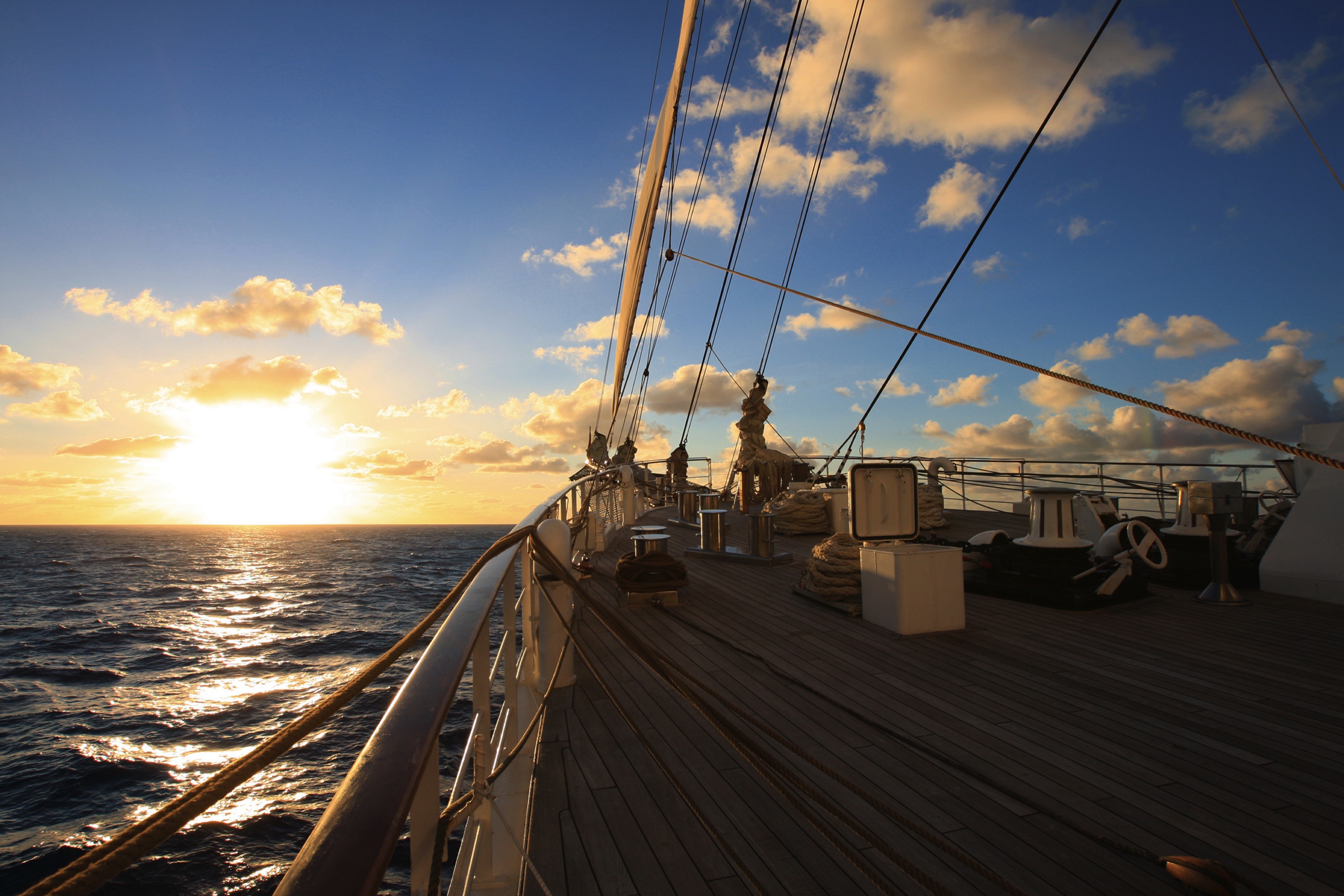
On Deck
To watch the movement of the sails and all the traditional tasks associated with a tall ship is for many people one of the most wonderful experiences on the high seas. On all the decks you will of course find many traditional deckchairs and benches on which you can sit alone or in a small group, gazing out to sea. On the sun deck you will also find two large sun loungers and the bridge. The officers will be happy to welcome you into the command centre – manoeuvres permitting.
Our snorkelling equipment can be taken ashore at any time. The on-board zodiac boats do not only take you ashore and back to the SEA CLOUD II, but are also used to tow the “Fun Island”, our inflatable water sled for those who fancy some high-speed fun! Depending on sea conditions, the swim platform provides direct access to the largest swimming pool in the world: the sea. And in the evening, the lido deck is a wonderful place to wind down with a nice drink. You might also be entertained by our Crew Shanty Choir.
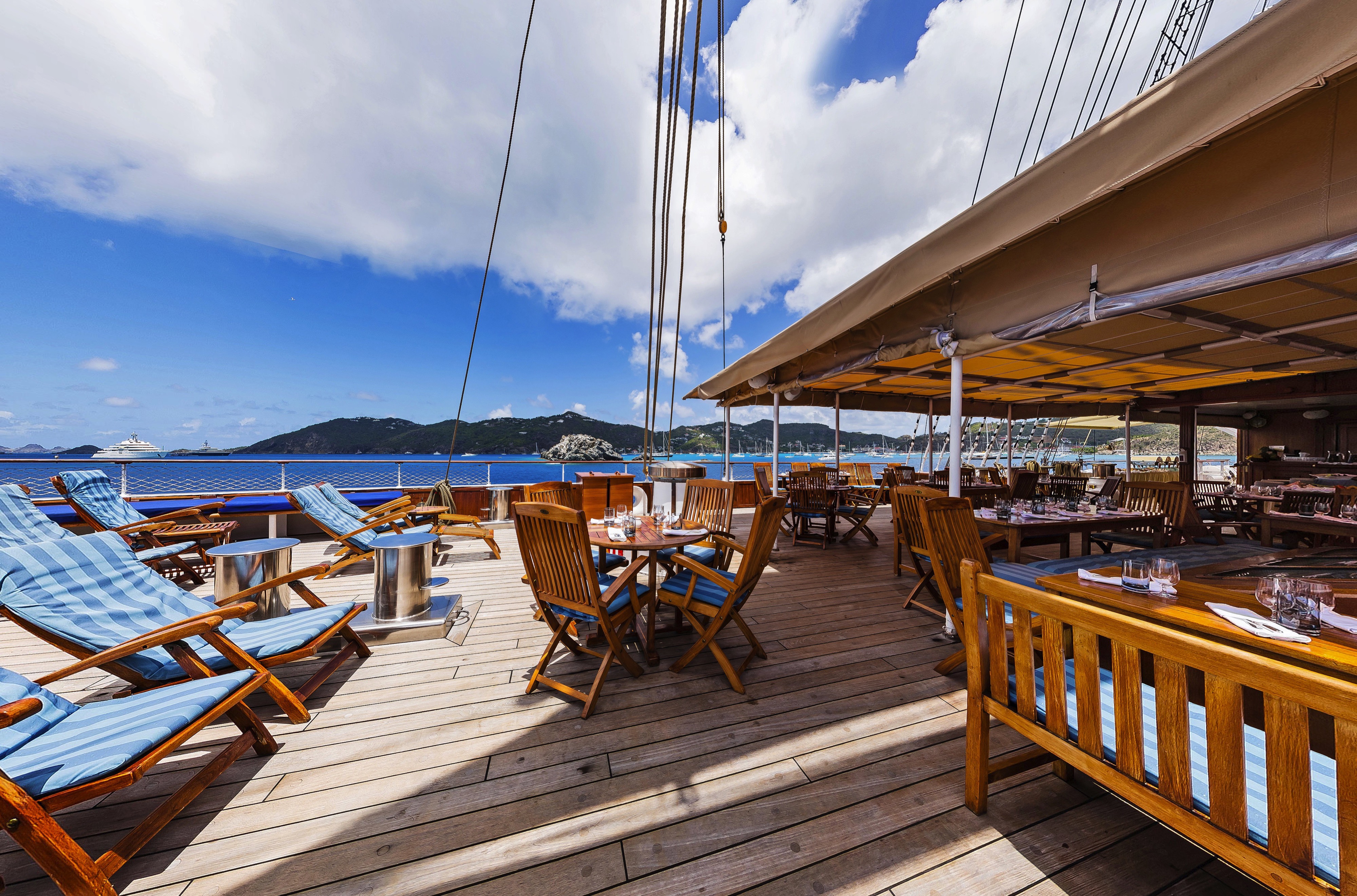
Lido Deck with Bar
The Lido bar is open daily from 11:00 am. Soft drinks, coffee, tea, water and juices are available all day free of charge.
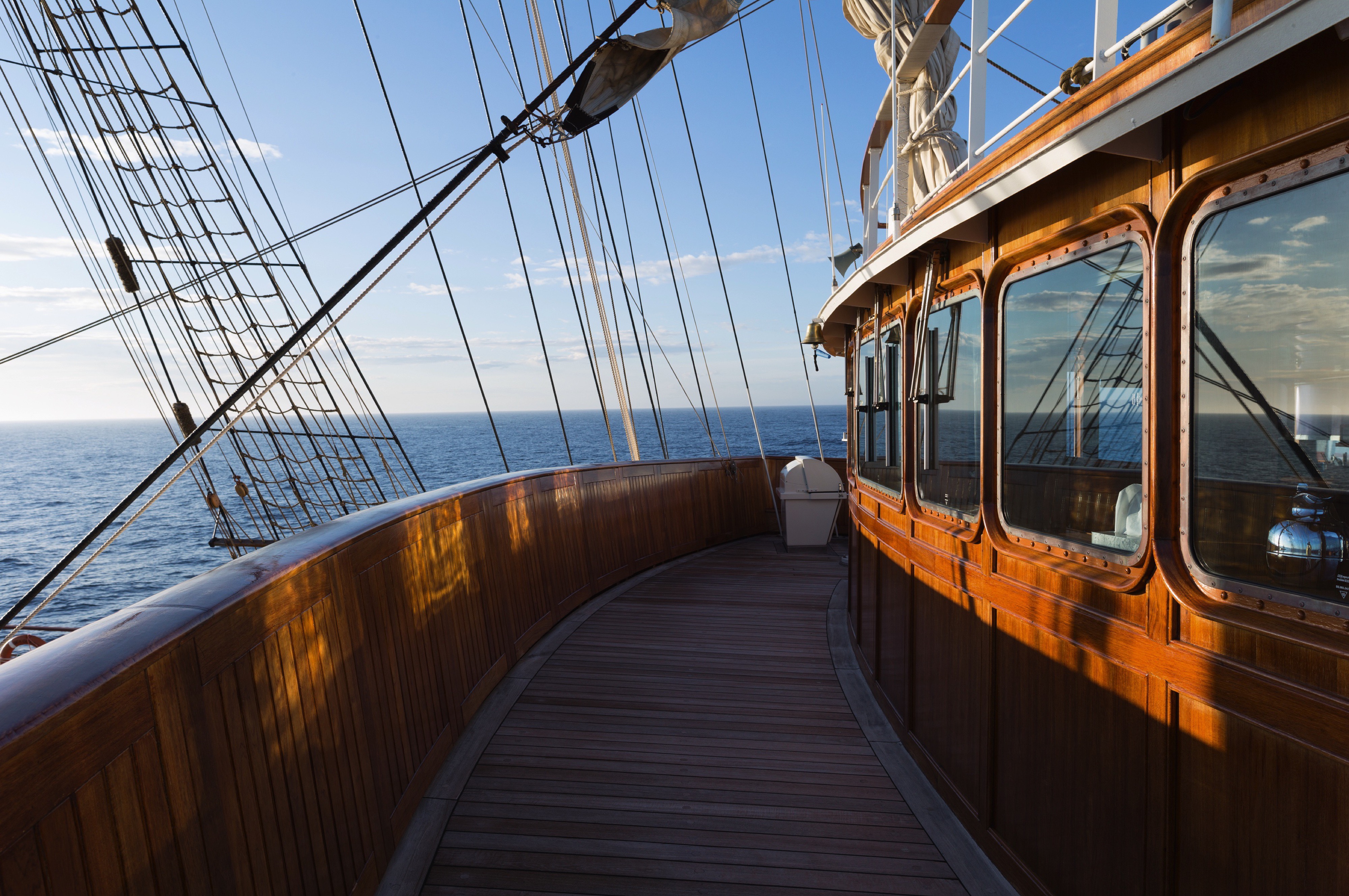
Bridge
The Bridge can be located on the Sun Deck.
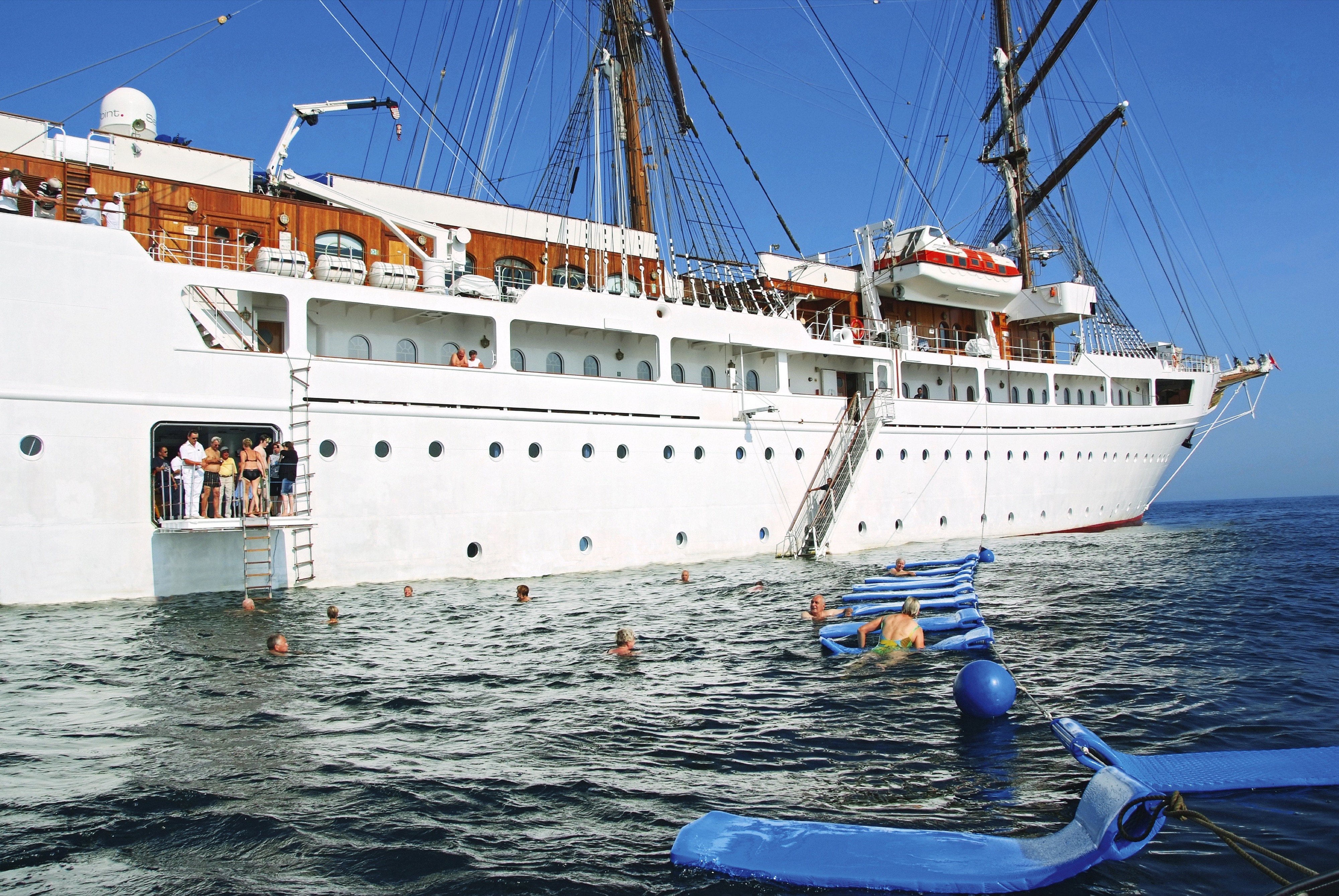
Swim Platform
The Swim Platform is located on the cabin deck.
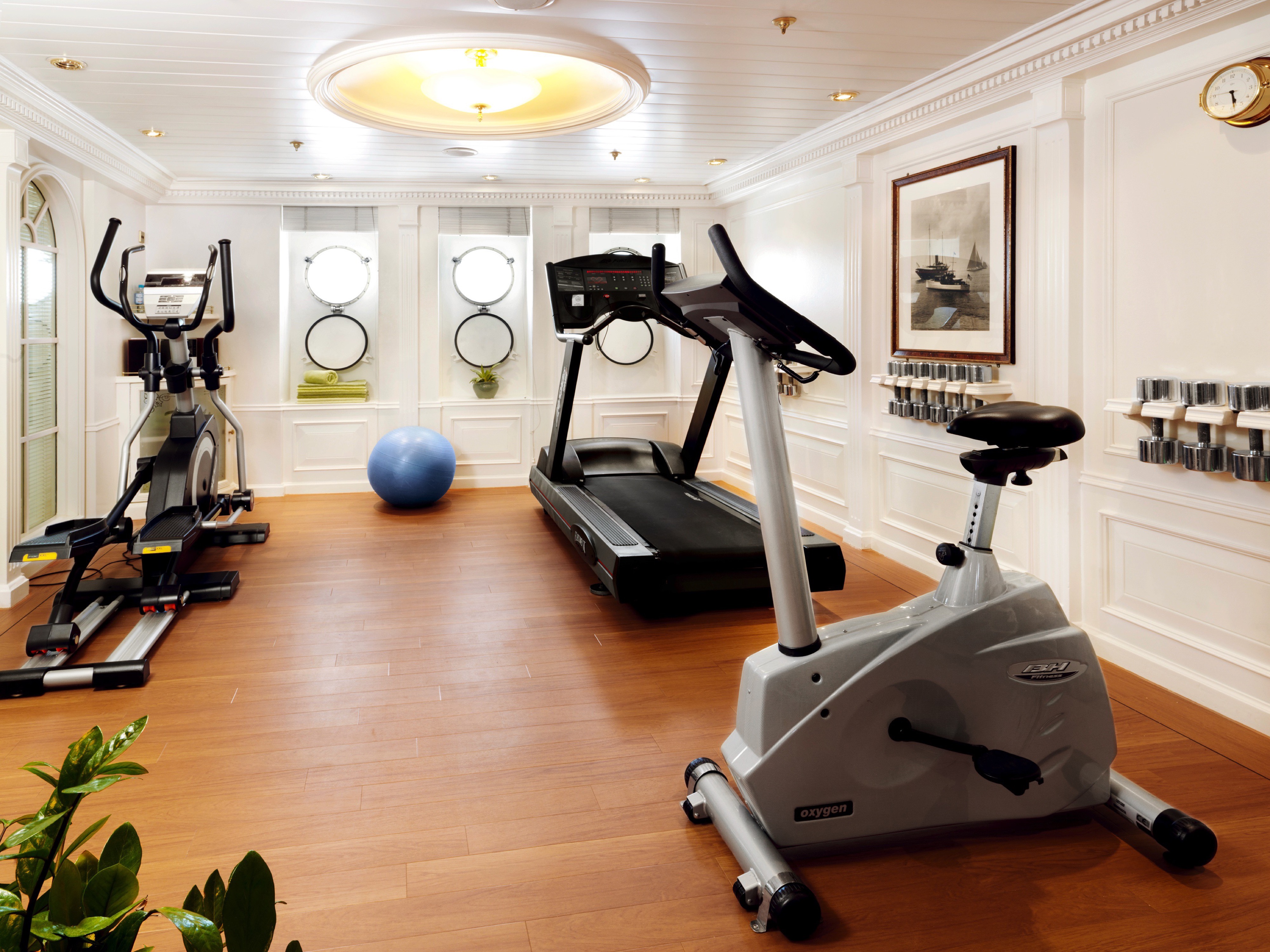
Fitness and Sport
Fitness enthusiasts can use the 100-metre long lido deck as their running/walking circuit while taking in all the different views which you can expect on board a tall ship. For others, our morning exercise sessions are just the way to start a new day. In the smart fitness studio, you will find dumbbells, bikes, treadmills and step machines for more focused workouts, and the adjoining sauna area will enhance your general well-being.
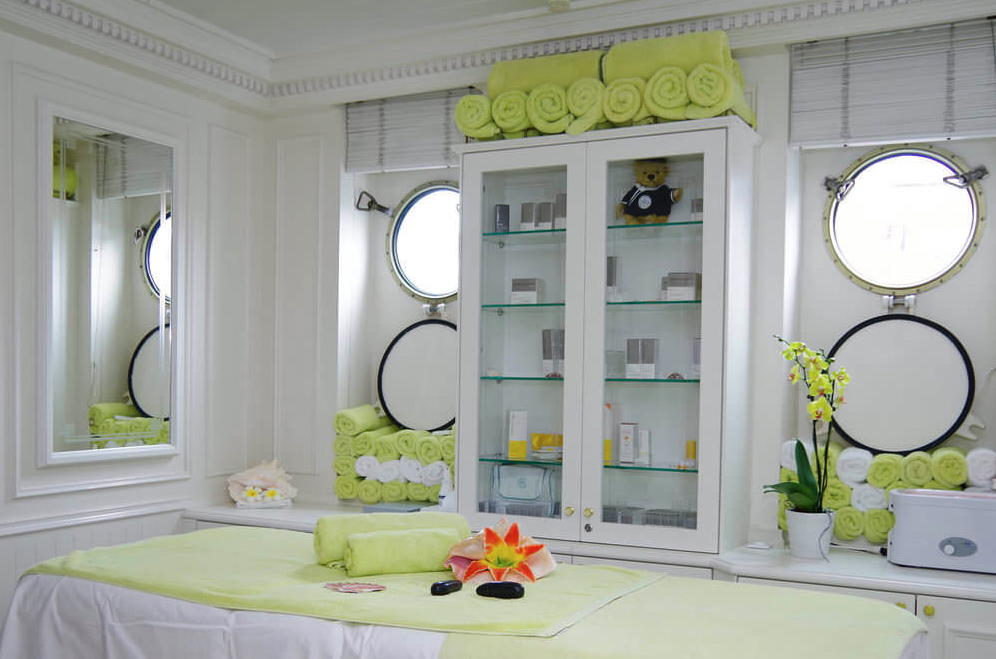
Massage & Cosmetics
We provide a range of spa services on board the SEA CLOUD II (massages and beauty treatments at additional cost), using the finest products from Maria Galland.
Special Dietary Requirements
The chef will happily accommodate special diet requests—please let us know about any requests in advance so that we may prepare.
Dress Code
During the day, and depending on the weather, a sophisticated summer look is suitable. For the evening, we recommend smart-casual wear. We also kindly request that guests refrain from wearing shorts at evening meals. The Captain’s Dinner (an event which normally takes place twice on each trip – once on short cruises) is a time when our guests tend to opt for a more elegant look. We recommend a suit for men and appropriate smart dress for women. Please remember to take some non-slip shoes with you.
Disabled Access
Our tall ships SEA CLOUD and SEA CLOUD II are not accessible for all people with disabilities and are not suitable for wheelchair users. Please contact our cruise consultancy for further details.
Smoking Policy
Smoking is permitted only on the outer decks outside of meal times. We kindly request that smokers take the comfort of other passengers into consideration. Smoking is prohibited on the blue lagoon deck and covered areas of the spanker and lido deck at all times.
Wi-Fi
Our yachts are equipped with Starlink. WIFI is available in the public areas on all ships and in your cabin on SEA CLOUD SPIRIT. You can use your own laptop, tablet, or smartphone to connect to the internet with the access code (WIFI) for a fee. WIFI packages can be purchased at the reception. Please note that WIFI service on board is not comparable to on land and might be interrupted at times due to lack of coverage in certain areas.
Laundry Services
Laundry services available on board are limited to washing and ironing. There is no dry-cleaning available. The washing and ironing service is provided at an additional charge and is carried out overnight. For guests with bookings in Cat. A-C (SEA CLOUD) or Cat. A+B (SEA CLOUD II), this service is free of charge. For safety reasons, passengers are not permitted to iron in their cabins.
Children on Board
Children are of course very welcome on our ships, however there is no supervision or entertainment available for children.
Sustainability & Low Impact Tourism
We approach the people and their cultures with respect in all the regions we visit, travelling mindfully through the local environment. By doing this, we can bring our guests closer – in the truest sense of the word – to these places, and what makes each one special.
THE WINDJAMMER EXPERIENCE
For you and us alike, the key attraction of our trips is the chance to sail on the open seas.
We therefore take every opportunity to set sail and be propelled by the sheer power of the wind. That is why the captain will sometimes change the route if the weather requires it. On board our SEA CLOUD tall ships, you’ll experience the elements, as many of the day-to-day activities take place outside.
HAVING AS LITTLE IMPACT AS POSSIBLE
When we do have to start the engines, we utilise low-sulphur marine diesel on all three of our windjammers.
For us, this is standard practice. Even the SEA CLOUD, our very first windjammer, was equipped with this technology right from the start. Our motto: to minimise our impact on the environment yet still make a profound and positive impression on those around us.
A SUSTAINABLE APPROACH TO LIFE ON-BOARD
Avoiding plastic, reducing water usage and protecting the environment.
These are the factors that guide us in the day to day operation of our ships and our ongoing development of eco-friendly alternatives. To cite just one example, our reusable drinks bottles are not only easy on the eye, but also easy on the environment.
QUALITY, NOT QUANTITY
Our ‘small but perfectly formed’ windjammers are able to visit smaller ports, away from the busy routes frequented by large cruise liners.
With a maximum of 64 to 136 passengers, we’re always welcomed in those locations thanks to our approach of visiting local communities rather than overwhelming them. Needless to say, our itineraries also include some classic destinations, though we usually visit these only when the mega-liners have moved on.
BOOSTING THE LOCAL ECONOMY
Procuring supplies locally, working with local, smaller-scale agencies and paying fair prices.
By taking this approach, we see ourselves as a partner for our local service providers, with whom we’ve built relationships based on trust over many years. After all, we want our voyages to benefit both our guests and the communities we visit around the world.
AUTHENTIC CUISINE
Our menus are always a true reflection of the regional cuisine.
This is because our chefs enjoy buying exotic spices, local specialities and freshly caught fish from local markets to bring you – even in a culinary sense – closer to the places we visit.
A MEMBER OF THE FUTOURIS NETWORK
Heading into the future with Futouris.
Preserving the natural and cultural heritage of our world and shaping the future of tourism in a sustainable way is what Futouris stands for. Members of the network are working globally to improve people’s living conditions, preserve biodiversity and protect the environment and climate.
Medical Facilities
All three ships have a hospital, which is supervised by a ship’s doctor. Medical consultation hours can be found in the daily program. In case of an emergency, the doctor can be reached at any time by calling 911.

Sun Deck
- Captain
- Bridge

Lido Deck
- Lounge
- Lido Bar
- Lido Deck
- Library
- Luxury Owner Suites

Promenade Deck
- Restaurant
- Boutique
- Purser
- Reception
- Junior Suites
- De luxe double-bed cabins

Cabin Deck
- Fitness Area
- Massage and Cosmetics
- Hospital
- Swim Platform
- De luxe double-bed cabins
- Upper/Lower-bed Cabins

